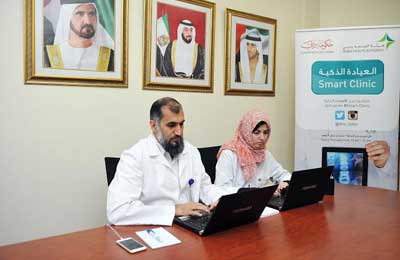
DHA launches stroke awareness campaign
DUBAI, December 19, 2014
The Dubai Health Authority discussed ways of stroke prevention during its smart clinic, with the launch of a stroke awareness campaign.
Dr Suhail Al Rukn, stroke and neurology consultant and head of stroke unit at Rashid Hospital, said: “Stroke awareness in the UAE is particularly important. About 50 per cent of the stroke patients in the UAE are below the age of 45 years, as compared to the global average, where 80 per cent of stroke patients are above the age of 65 years. For the UAE, this is an alarming statistic and calls for urgent lifestyle changes and increase in awareness.”
The reason for this is sedentary lifestyle, diabetes, obesity, dependence on fatty foods and a diet high in salts, he said.
“In the UAE, 18 to 20 per cent of the population is obese, 20 per cent of population are diabetics. Moreover, high salt consumption is a major issue. The average amount of salt needed on a daily basis in 2 grams, however, the average amount of salt people in the UAE consume per day is 15 grams which is way above the required limit.”
Dr Rukn added that stroke is third leading cause of death in the world and the main reason for adult disability.
According the latest data by the World Health Organization (WHO) in upper –middle income countries, stroke is the leading cause of death, followed by cardiac diseases.
In the UAE, after road accidents, stroke is the second leading cause of disability.
Annually 7,000 to 8,000 patients in the UAE get a stroke, this means every hour, one person gets a stroke. Internationally the number is 100 to 120 cases per 100,000, so the country is within the international range, however, unfortunately in the UAE stroke patients are much younger than those in western countries.
Dr Rukn said that it is essential for people to be aware of risk factors, to conduct yearly health screenings and those with one or more risk factors, can opt for the stroke risk calculator test, which basically tabulates the likelihood of a person getting a stroke in the next ten years.
He said the risk factors include, diabetes, obesity, hypertension, high cholesterol, smoking, heart disease, previous stroke, alcohol and age (above 55 years).
According to the Stroke Association, women who take even a low-estrogen birth control pill may be twice as likely to have a stroke than those who are not on the pill and the risk may increase if other risk factors are present.
Also, women who take hormone replacement therapy may have a slightly increased stroke risk.
Dr Zaibunnisa Khan, specialist registrar in the neurology department at Rashid Hospital, said: “It is recommended that women be screened for high blood pressure before starting on the pill. Users of oral contraceptives who have one or more additional risk factors for stroke – such as hypertension, or obesity should pursue treatment of those risk factors while on the pill.
“ As long as other risk factors are under control or not present, women can continue taking oral contraceptive pills in consultation with their gynaecologist.
“Women on oral contraceptive pills, should be well-hydrated, they are also more prone to weight gain, therefore they should exercise regularly and maintain a healthy diet to avoid the risk of stroke.”
The most important factor in minimising the disability caused by a stroke is immediate medical attention, said Dr Rukn.
“The thing about strokes is that it occurs suddenly and the damage takes place very quickly, the longer it takes a person to get medical assistance, the more the brain damage. An adult brain has a total of five to six billion brain cells, when a stroke occurs, brain cells start to die. It has been estimated that 1.9 million brain cells die per minute in a stroke case. Therefore, the level of disability can be quite severe as the effects of a stroke on the body are immediate.”
Dr Rukn said an important message to the community is that they should be aware of what to do in case a person is having a stroke as immediate medical intervention is important.
“Unfortunately, so many people die every year and many are left to endure severe or prolonged disability because they didn’t get to a hospital quick enough after having a stroke.”
Dr Rukn said that a simple process can help family members identify if a person is having a stroke or not.
“It’s called the FAST test, the details are: Face: check whether the person’s face has fallen to one side and whether the person can smile or not. Arms: Can the person raise both arms or not? Speech: Can the person speak or is the speech slurred? And lastly, Time: If any of the three signs are visible, it’s important to call the ambulance right away.”
Dr Rukn said the first four and a half hours after the person gets a stroke are most crucial for doctors to minimise the damage to the brain and thus getting to a hospital on time is crucial, ideally the patient should be taken to the hospital as soon as the symptoms are recognised, within the first three hours.
“This leaves doctors with time to start treatment before the four and half hour window period is over.”
People above the age of 30 should check their blood pressure every year and that there is a strong link between hypertension and stroke, said Dr Rukn.
He also advocated that people should bring about meaningful lifestyle changes to minimise their risk of developing a stroke. - TradeArabia News Service







